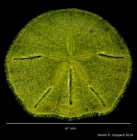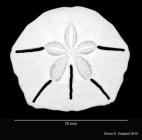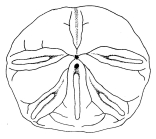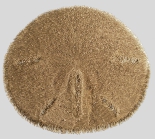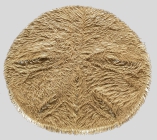
| Introduction | | Search taxa | | Taxon tree | | Specimens | | Attributes | | Literature | | Photo gallery | | Stats | | Log in |
Echinoidea taxon detailsLanthonia Coppard, 2016
880815 (urn:lsid:marinespecies.org:taxname:880815)
accepted
Genus
Mellita longifissa Michelin, 1858 accepted as Lanthonia longifissa (Michelin, 1858) (type by original designation)
marine,
recent + fossil
Coppard, S. E. (2016). A new genus of mellitid sand dollar (Echinoidea: Mellitidae) from the eastern Pacific coast of the Americas. <em>Zootaxa.</em> 4111(2): 158-166., available online at https://doi.org/10.11646/zootaxa.4111.2.4
page(s): 160-164 [details] Available for editors
Etymology ‘Lanth’ meaning hidden and ‘onia’ a diminutive ending (gender feminine).
Etymology ‘Lanth’ meaning hidden and ‘onia’ a diminutive ending (gender feminine). [details]
Kroh, A.; Mooi, R. (2025). World Echinoidea Database. Lanthonia Coppard, 2016. Accessed at: https://www.marinespecies.org/echinoidea/aphia.php?p=taxdetails&id=880815 on 2025-05-03
Date action by
original description
Coppard, S. E. (2016). A new genus of mellitid sand dollar (Echinoidea: Mellitidae) from the eastern Pacific coast of the Americas. <em>Zootaxa.</em> 4111(2): 158-166., available online at https://doi.org/10.11646/zootaxa.4111.2.4
page(s): 160-164 [details] Available for editors context source (PeRMS) Solís-Marín, F. A.; Alvarado, J. J.; Abreu-Pérez, M.; Aguilera, O.; Alió, J.; Bacallado-Aránega, J. J.; Barraza, E.; Benavides-Serrato, M.; Benítez-Villalobos, F.; Betancourt-Fernández, L.; Borges, M.; Brandt, M.; Brogger, M. I.; Borrero-Pérez, G. H.; Buitrón-Sánchez, E.; Campos, L. S.; Cantera, J.; Clemente, S.; Cohen-Renjifo, M.; Coppard, S.; Costa-Lotufo, L. V.; del Valle-García, R.; Díaz, Y.; Díaz de Vivar, M. E.; Díaz-Martínez, J. P.; Durán-González, A.; Epherra, L.; Escolar, M.; Francisco, V.; Freire, C. A.; García-Arrarás, E.; Gil, D. G.; Guarderas, P.; Hadel, V. F.; Hearn, A.; Hernández, J. C.; Hernández-Delgado, E. A.; Herrera-Moreno, A.; Herrero-Pérezrul, M. D.; Hooker, Y.; Honey-Escandón, M. B. I.; Lodeiros, C.; Luzuriaga, M.; Manso, C. L. C.; Martín, A.; Martinez, M. I.; Martínez, S.; Moro-Abad; Mutschke, E.; Navarro, J. C.; Neira, R.; Noriega, N.; Palleiro-Nayar, J. S.; Pérez, A. F.; Pérez-Ruzafa, A.; Prieto-Rios, E.; Reyes, J.; Rodríguez, R.; Rubilar, T.; Sancho-Mejía, T.; Sangil, C.; Silva, J. R. M. C.; Sonnenholzner, J. I.; Ventura, C. R.; Tablado, A.; Tavares, Y.; Tiago, C. G.; Tuya, F.;Williams, S. M. (2013). Appendix. <em>In: J. J. Alvarado & F. A. Solís-Marín (eds), Echinoderm Research and Diversity in Latin America.</em> pp. 471-510. Springer; Berlin & Heidelberg. page(s): 543-654. [details] From editor or global species database
Diagnosis Members of Lanthonia possess diagnostic features of the family Mellitidae, but are distinguished from members of Mellita by the presence of very narrow ambulacral regions between the food grooves and the ambulacral lunules on the oral surface, and by the structure of the bidentate pedicellariae which have simple valves (with no projecting stereom within the blades of the valves) and small peripheral teeth present along the edge of the blade. [details]Etymology ‘Lanth’ meaning hidden and ‘onia’ a diminutive ending (gender feminine). [details] |
